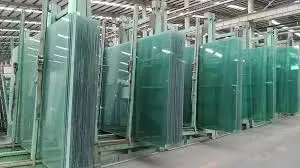The Process of Tempered Glass A Comprehensive Overview
Tempered glass, also known as toughened glass, is a type of safety glass that is chemically or thermally treated to enhance its strength compared to normal glass. This specialized glass is widely used in applications where safety and durability are paramount, such as in windows, doors, facades, and shower screens. Understanding the tempered glass process is essential for manufacturers and end-users to appreciate the unique properties and benefits of this material.
The tempered glass process begins with the selection of raw glass, typically in sheet form
. This glass is initially cut to the desired size and shape, ensuring that it meets the specifications for its intended application. The sheets are then thoroughly cleaned to remove any impurities, dust, or oils that might interfere with the subsequent processing steps.
Once the glass is prepared, the next critical step involves heating. The glass sheets are placed in a furnace where they are gradually heated to a temperature of around 600 to 700 degrees Celsius (about 1112 to 1292 degrees Fahrenheit). This heating process is crucial, as it alters the internal structure of the glass, making it more uniform and eliminating any internal stresses. The heating phase typically takes about 30 to 60 minutes, depending on the thickness of the glass and the desired outcome.
After reaching the appropriate temperature, the glass undergoes a rapid cooling process known as quenching. The heated glass is subjected to high-pressure jets of cold air, causing the surface to cool quickly while the interior remains hotter for a brief period. This temperature differential creates compressive stresses on the surface and tensile stresses within the core of the glass, resulting in a much stronger and more resilient product.
tempered glass process
This rapid cooling is what distinguishes tempered glass from standard glass, creating its characteristic toughness. In fact, tempered glass is about five to six times stronger than untreated glass of the same thickness. Moreover, when tempered glass does break, it shatters into small, blunt pieces, reducing the risk of severe injuries often associated with sharp glass shards.
Following the quenching process, the tempered glass can undergo additional steps based on the specific requirements of its application. This may include edgework, which involves polishing and finishing the edges to improve aesthetics and safety, and coating, which provides added protective features such as UV resistance or anti-reflective properties.
In addition to manufacturing, the tempered glass process adheres to strict safety standards and regulations to ensure quality and performance. Various testing methods are employed to evaluate the strength, thermal resistance, and optical clarity of the glass, ensuring that it meets industry standards set by organizations such as ASTM International and the American National Standards Institute (ANSI).
In conclusion, the tempered glass process transforms ordinary glass into a robust and safe material suitable for various applications. Its ability to withstand significant mechanical stress, thermal fluctuations, and impact makes it an ideal choice for modern architecture and design. Understanding this intricate process not only highlights the technical expertise involved but also underscores the importance of tempered glass in enhancing safety and durability in our daily lives.
 Afrikaans
Afrikaans  Albanian
Albanian  Amharic
Amharic  Arabic
Arabic  Armenian
Armenian  Azerbaijani
Azerbaijani  Basque
Basque  Belarusian
Belarusian  Bengali
Bengali  Bosnian
Bosnian  Bulgarian
Bulgarian  Catalan
Catalan  Cebuano
Cebuano  Corsican
Corsican  Croatian
Croatian  Czech
Czech  Danish
Danish  Dutch
Dutch  English
English  Esperanto
Esperanto  Estonian
Estonian  Finnish
Finnish  French
French  Frisian
Frisian  Galician
Galician  Georgian
Georgian  German
German  Greek
Greek  Gujarati
Gujarati  Haitian Creole
Haitian Creole  hausa
hausa  hawaiian
hawaiian  Hebrew
Hebrew  Hindi
Hindi  Miao
Miao  Hungarian
Hungarian  Icelandic
Icelandic  igbo
igbo  Indonesian
Indonesian  irish
irish  Italian
Italian  Japanese
Japanese  Javanese
Javanese  Kannada
Kannada  kazakh
kazakh  Khmer
Khmer  Rwandese
Rwandese  Korean
Korean  Kurdish
Kurdish  Kyrgyz
Kyrgyz  Lao
Lao  Latin
Latin  Latvian
Latvian  Lithuanian
Lithuanian  Luxembourgish
Luxembourgish  Macedonian
Macedonian  Malgashi
Malgashi  Malay
Malay  Malayalam
Malayalam  Maltese
Maltese  Maori
Maori  Marathi
Marathi  Mongolian
Mongolian  Myanmar
Myanmar  Nepali
Nepali  Norwegian
Norwegian  Norwegian
Norwegian  Occitan
Occitan  Pashto
Pashto  Persian
Persian  Polish
Polish  Portuguese
Portuguese  Punjabi
Punjabi  Romanian
Romanian  Russian
Russian  Samoan
Samoan  Scottish Gaelic
Scottish Gaelic  Serbian
Serbian  Sesotho
Sesotho  Shona
Shona  Sindhi
Sindhi  Sinhala
Sinhala  Slovak
Slovak  Slovenian
Slovenian  Somali
Somali  Spanish
Spanish  Sundanese
Sundanese  Swahili
Swahili  Swedish
Swedish  Tagalog
Tagalog  Tajik
Tajik  Tamil
Tamil  Tatar
Tatar  Telugu
Telugu  Thai
Thai  Turkish
Turkish  Turkmen
Turkmen  Ukrainian
Ukrainian  Urdu
Urdu  Uighur
Uighur  Uzbek
Uzbek  Vietnamese
Vietnamese  Welsh
Welsh  Bantu
Bantu  Yiddish
Yiddish  Yoruba
Yoruba  Zulu
Zulu 

